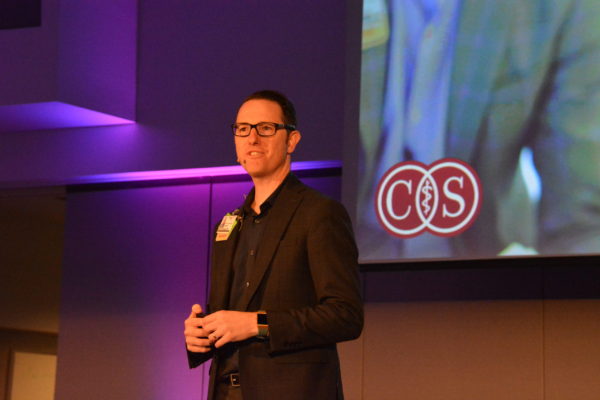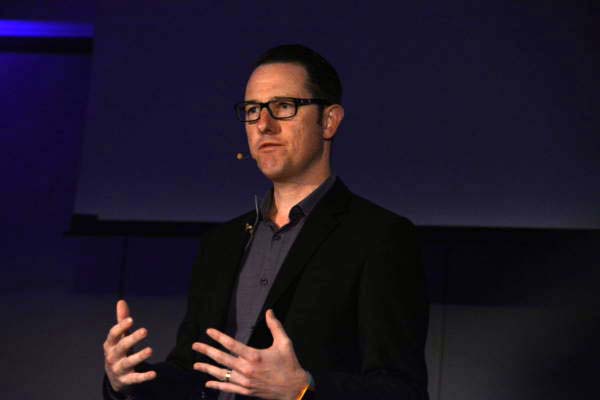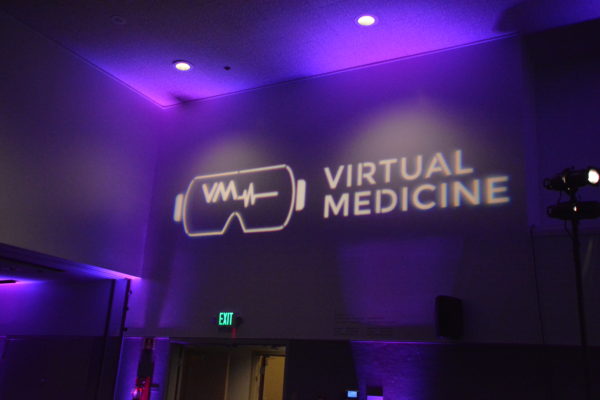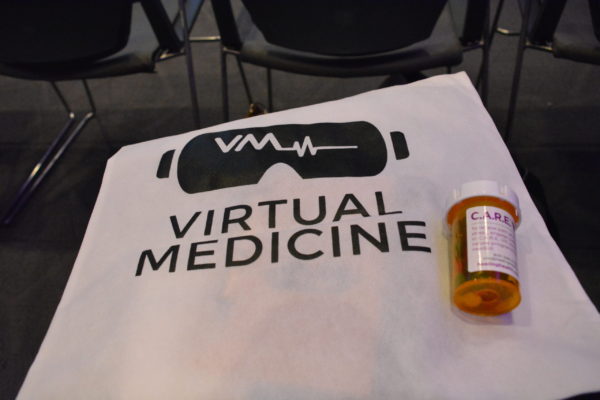by Dot Cannon

Dr. Brennan Spiegel presents at Cedars-Sinai’s 2018 “Virtual Medicine” conference
“This is truly a time like no other,” said Dr. Brennan Spiegel.
Tuesday morning, June 30th, marked the first of Cedars-Sinai ‘s new “Virtual Medicine Webinar Series” sessions. (Normally, as covered previously, Cedars-Sinai hosts an annual “Virtual Medicine” conference in Los Angeles. However, the pandemic forced them to cancel this year’s two-day event. Instead, they’ve re-imagined it as a new virtual series.)
Entitled, “Virtual Care: The Role of VR in an Unprecedented Time”, this first two-hour program would explore VR’s role in addressing the current challenges presented by racial bias and the COVID-19 pandemic.
Dr. Spiegel, who is Cedars-Sinai’s Director of Health Services Research, served as the first speaker. In his presentation entitled, “The Empathy Machine: How Virtual Reality Brings the Humanity Back into Healing”, he illustrated the ways VR can break down unwanted–and sometimes unconscious–barriers.
Showing a slide of his office, Dr. Spiegel said, “If you look at the way this is set up, there’s a computer screen right there between the doctor and the patient. It separates me physically, and even emotionally, from my patient.”
The danger, he added, was that medical professionals can focus on the codes instead of the person.
An added challenge, he said, was that now, doctors are frequently “not even…physically in the same location as the patient”.
“Not that the empathy has gone anywhere. It’s still there, but this is an opportunity (to empathize through VR).”
Empathy from “experience”
Next. Dr. Spiegel showed a slide of alphanumeric codes.
“Think about this one here in the middle,” he said. “This is an alphanumeric code that indicates physical abuse.”
While he himself has never experienced abuse, Dr. Spiegel told the audience, he now can empathize with a patient in that situation. What he did experience, was a VR simulation at the University of Barcelona.
“I experienced what it’s like to be in a domestic-abuse situation–as a woman,” he explained, before showing a short video of the scenario.
In it, a man enters a room, snarls a series of disparaging remarks at the user, and concludes with, “I’m doing this because I love you”.
“When I took off the headset after the experience, I was just silent,” Dr. Spiegel said. “I was shaking, literally.”
“I can’t pretend to know what it’s like to be a victim. (But now I can empathize.)”
Applications for empathy–and change

Dr, Brennan Spiegel during Cedars-Sinai’s Inaugural “Virtual Medicine” conference, Los Angeles, 2018.
Dr. Spiegel told his audience that studies have also shown that the use of virtual reality can increase empathy for the elderly, patients with disabilities and the homeless.
“As a doctor, I try always to empathize with my patients,” he continued. “But do I know what it’s like to be blind? …Or experience dementia?”
Again, he pointed to a slide with numerous alphanumeric codes.
“G30.9. That’s Alzheimer’s Disease. (What’s it like to have Alzheimer’s Disease…or be a family member of someone with Alzheimer’s?)”
In addition, Dr. Spiegel said, the use of virtual reality could help doctors become more empathetic with demanding patients–and even, help patients be more empathetic with themselves.
Dr. Spiegel referenced a project Cedars-Sinai had done with Holman United Methodist Church. The team created a virtual kitchen, allowing parishioners to “fly” through their bodies and see how different foods affected various organs.
(Here is the link to our earlier coverage of speakers discussing the Sodium Healthy Living Project during Cedars-Sinai’s first “Virtual Medicine ” conference in 2018.)
“(After the study), we found a seven-percent drop in systolic blood pressure, which is remarkable,” Dr. Spiegel commented.
Concluding his presentation, Dr. Spiegel referenced one other study, where HIV patients could use VR to see the ways in which medications interacted with their bodies.
“It’s the moment when you take off the headset,” he said.
“This is the moment where world views can change, and it’s really remarkable.”
New directions, new opportunities

Virtual Medicine sign onsite during Virtual Medicine conference 2019, Los Angeles
“In many ways, the challenges of COVID have presented us with some of the greatest opportunities,” said Dr. Rob Louis.
Dr. Louis, who is Hoag Memorial Hospital’s Empower360 Endowed Chair for Skull Base and Minimally Invasive Neurosurgery, said he’d been working with AR and VR since 2015.
“It’s difficult to talk to patients about brain surgery, because it’s very abstract,” explained Dr. Louis, who is also Director of the Skull Base and Pituitary Tumor Program at Hoag Memorial Hospital’s Pickup Family Neurosciences Institute.
But, in his presentation entitled “Optimizing Care Delivery: Extended Reality During an Unreal Time”, he illustrated the ways VR could simplify those concepts.
“My first foray into VR was using this for patient engagement,” Dr. Louis explained.
“We can use (virtual reality) to help our patients prepare for surgery (by literally flying them through their own brain).”
Comprehension–and retention
Dr. Louis said that increased patient engagement had measurable results.
“…Patients vote with their feet. (Our patient retention rate) went up to 96 percent, from 64 percent.”
In addition, he said, patient comprehension of the procedures they were to undergo had increased dramatically.
“Almost 90 percent of our patients are rating their understanding of their brain surgery as a 9 or a 10,” Dr. Louis said
Next, he explored the use of VR in place of opioids, for chronic pain management.
“(Opioid abuse has killed half the number of people who have currently died of COVID-19,)” he said. “This is a problem we have to solve, and VR is one of (our) tools to decrease pain.”
Chronic pain control, Dr. Louis explained, was significantly improved by teaching patients about their pain through the use of virtual reality.
“Why is this so? …VR, by nature of its immersiveness, captures all four learning systems.”
VR against stress
But to implement that teaching system, some hurdles had to be overcome first. One obstacle: nurse buy-in to the use of VR, rather than medications.
Then came the pandemic. And now, virtual reality has become a key tool for stress management among healthcare workers and patients alike.
Dr. Louis explained how Hoag Memorial had implemented their XR program.
“We took eight nurses that would have been furloughed, and used them to get (our) extended reality program off the ground,” Dr. Louis explained.
The virtual-reality scenario, he said, took the nurses into a meditation room after their workday. Having the nurses experience therapeutic VR, along with a cleanbox technology that sanitized the headsets, allowed the staff at Hoag to get nurse buy-in to the use of the technology.
And in fact, the nurses not only accepted that use–they contributed ideas.
“The nurses suggested giving patients a choice (of VR experiences),” Dr. Louis said. “(Now) we have a laminated menu of choices for patients…In a total of six weeks, we’ve treated 494 patients (with virtual reality).
“One patient who went home said, ‘With the use of VR, I’ve been able to decrease my pain medication by half.'”
“Now I believe that (the use of VR to decrease stress and anxiety) is ready for prime time,” Dr. Lewis concluded.
“The need for these is now.”
A VR prescription for pain

“Virtual Medicine’ conference bag and candy on table during 2018 Virtual Medicine conference, Los Angeles.
“Up to 100 million Americans are living with chronic pain of some type,” said Dr. Beth Darnell at the start of her presentation, “Virtual Reality for Scalable, Home-Based Chronic Pain Management”.
(“And ir’s eventually going to affect all of us, if we’re lucky enough to live long enough to experience it.”)
Dr. Darnell, who is Director of Stanford University’s Pain and Brain Innovations Lab, outlined a vicious cycle of sorts.
“Pain is influenced by a number of modifiable biopsychosocial factors. (It’s) naturally distressing, and communicates to each of us to escape whatever is causing the pain.”
“…Poor cognition and emotion regulation…lead to this whole host of (negative behavior patterns that can ultimately facilitate future pain).”
Dr. Darnell told her audience that the Stanford Pain Relief Innovations Lab has been conducting workshops, using virtual reality, in which patients acquire the skills to modulate pain.
Staffers, she explained, did a randomized control trial for a skills-based VR program. Conducting a study among 97 adults with either back pain or fibromyalgia, they taught them how pain operates in the central nervous system. Patients learned to regulate their breathing to control pain, while self-regulating the emotional dimensions of the pain experience.
However, some patients went through the program with just audio devices. Others received virtual reality headsets.
“We found a substantial reduction in pain for the VR (group), versus (those that used) audio only,” Dr. Darnell said.
“We are just getting ready to launch a new study: a second, randomized control trial of people with chronic pain,” she explained.
“VR for chronic pain is exciting because we have the ability to provide Americans with a scalable and effective (means to control their pain).”
VR goes remote

Dr. Brandon Birckhead presents during Cedars-Sinai “Virtual Medicine 2018” conference, in Los Angeles.
“One thing to say about remote studies: the big addition is Deep 6 AI,” said Cedars-Sinai Project Scientist Dr. Brandon Birckhead, during his presentation, “Conducting Remote Clinical Trials in the Era of COVID-19: An Example NIH Protocol Using Home-Based VR”.
(Deep 6 AI, Dr. Birckhead explained, is artificial intelligence that allows health-care professionals to search medical data and find eligible patients for clinical studies more rapidly.)
“With AI, classically, we nab traffic and it’s a great time to talk to patients about a study that they might be interested in engaging with.”
Dr Birckhead, who, with Dr. Spiegel, is Co-Director of Cedars-Sinai’s Virtual Medicine Conference, referenced several important considerations for conducting home-based VR trials. The first one he mentioned was cleaning methods.
“We wipe (the headsets) down every five days,” he said, adding that Cedars also uses UV light for sterilization.
Another consideration, Dr. Birckhead added, was the importance of letting the patient know how much time is involved in a remote study. Given the fact that the patient and physician are physically distanced, he said, that can be a challenge.
“One thing many patients may do: their lives may be so busy that they don’t know (what’s involved in the study for which they’re signing up)”, he said.
But even with these obstacles, he continued, remote studies in the time of COVID-19 are making progress.
“There will be mistakes. We’ve had one or two devices (malfunction). One or two out of 250 (is good).”
This is Part One of a two-part series. Here’s the link to Part Two.
Find out more about Cedars-Sinai’s upcoming “Virtual Medicine Webinar Series” presentations, as well as future onsite Virtual Medicine conferences, at this link.
